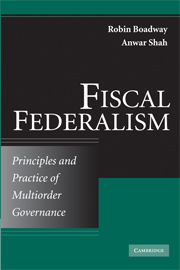Book contents
- Frontmatter
- Contents
- Preface
- PART ONE DESIGNING FISCAL CONSTITUTIONS
- PART TWO REVENUE SHARING AND FISCAL TRANSFERS
- PART THREE FINANCE AND PROVISION OF PUBLIC SERVICES
- 11 Finance and Provision of Health and Education
- 12 Finance and Provision of Infrastructure
- 13 Poverty Alleviation in Federations
- PART FOUR CHALLENGES AND RESPONSES
- References
- Index
12 - Finance and Provision of Infrastructure
Published online by Cambridge University Press: 05 June 2012
- Frontmatter
- Contents
- Preface
- PART ONE DESIGNING FISCAL CONSTITUTIONS
- PART TWO REVENUE SHARING AND FISCAL TRANSFERS
- PART THREE FINANCE AND PROVISION OF PUBLIC SERVICES
- 11 Finance and Provision of Health and Education
- 12 Finance and Provision of Infrastructure
- 13 Poverty Alleviation in Federations
- PART FOUR CHALLENGES AND RESPONSES
- References
- Index
Summary
Public-sector capital, including infrastructure, is an important component of public expenditures. The stock of public capital comes in various forms. Some types of public goods are durable by their very nature. Defense spending, for example, includes not only military personnel but also equipment like weapons, tanks, airplanes, and ships. Virtually all public programs, including the provision of public services to citizens, require buildings and associated equipment. The public sector may also be involved to a greater or lesser extent in providing infrastructure for use by the private sector. Examples include transportation facilities (e.g., roads, bridges) and communications installations. As essential components of an efficiently functioning private sector, these forms of infrastructure are well known to contribute to productivity and growth. This chapter addresses the implications for fiscal federalism that result from the significant capital component to public goods and services.
Acquisition of capital gives rise to special issues because of its durable nature. Current capital purchases result in both a stream of benefits and a need for maintenance and replacement in several periods into the future. This has two sorts of implications. First, the decision rules for providing public services must necessarily take account of this intertemporal aspect. Service provision requires not only current expenditures but also the building up of physical capacity to support this provision. Full account must be taken of the likely growth in demand for services in the future. This capacity will have to be maintained and replaced as it wears out.
- Type
- Chapter
- Information
- Fiscal FederalismPrinciples and Practice of Multiorder Governance, pp. 418 - 444Publisher: Cambridge University PressPrint publication year: 2009

